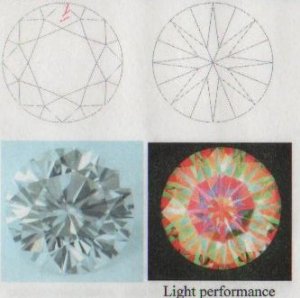Hey folks. This is my first post and I''d like to thank everyone for the great info I''ve been able to find on here through searches.
I just had the D SI-1 (round 1.02 carats) I picked up for my sweetheart''s engagement ring independantly graded (I''m in Toronto and didn''t trust gemscan''s pre-certs after reading some not so great opinions so I had it graded at Harold Weinstein. Everything was pretty much the same except the D color gemscan gave became an E color at Weinstein''s). Anyhow, Harold Weinstein included a Light Performance image on the grading report. I know that the more red the better, but I don''t really understand enough about the image to know what sort of light performance this diamond has. Anyone know how to read these things? I''ve attached a pic.
Also, you can see the diamond has three feather inclusions close to each other with one of them going out to the edge of the diamond. The diamond''s totally eyeclean (as far as my eyes could see) but I''m wondering if there''s any special care that needs to be given to that end of the diamond with that feather that goes out to the surface? Is that going to cause a problem?
Your help is much appreciated!
Serge

I just had the D SI-1 (round 1.02 carats) I picked up for my sweetheart''s engagement ring independantly graded (I''m in Toronto and didn''t trust gemscan''s pre-certs after reading some not so great opinions so I had it graded at Harold Weinstein. Everything was pretty much the same except the D color gemscan gave became an E color at Weinstein''s). Anyhow, Harold Weinstein included a Light Performance image on the grading report. I know that the more red the better, but I don''t really understand enough about the image to know what sort of light performance this diamond has. Anyone know how to read these things? I''ve attached a pic.
Also, you can see the diamond has three feather inclusions close to each other with one of them going out to the edge of the diamond. The diamond''s totally eyeclean (as far as my eyes could see) but I''m wondering if there''s any special care that needs to be given to that end of the diamond with that feather that goes out to the surface? Is that going to cause a problem?
Your help is much appreciated!
Serge











300x240.png)